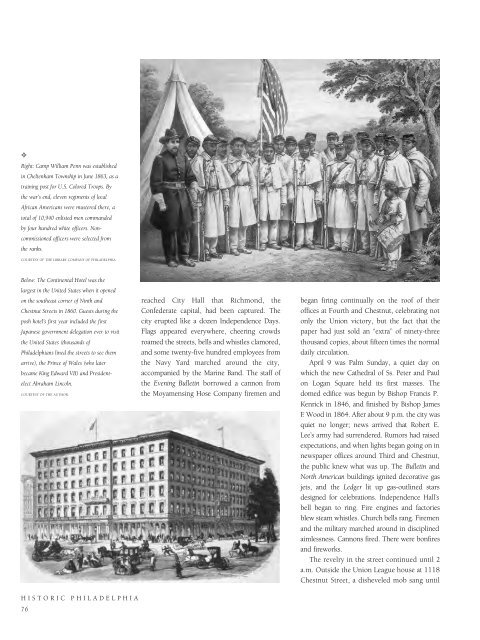Historic Philadelphia
An illustrated history of the city of Philadelphia, paired with the histories of companies, families and organizations that make the region great.
An illustrated history of the city of Philadelphia, paired with the histories of companies, families and organizations that make the region great.
Create successful ePaper yourself
Turn your PDF publications into a flip-book with our unique Google optimized e-Paper software.
✧<br />
Right: Camp William Penn was established<br />
in Cheltenham Township in June 1863, as a<br />
training post for U.S. Colored Troops. By<br />
the war’s end, eleven regiments of local<br />
African Americans were mustered there, a<br />
total of 10,940 enlisted men commanded<br />
by four hundred white officers. Noncommissioned<br />
officers were selected from<br />
the ranks.<br />
COURTESY OF THE LIBRARY COMPANY OF PHILADELPHIA.<br />
Below: The Continental Hotel was the<br />
largest in the United States when it opened<br />
on the southeast corner of Ninth and<br />
Chestnut Streets in 1860. Guests during the<br />
posh hotel’s first year included the first<br />
Japanese government delegation ever to visit<br />
the United States (thousands of<br />
<strong>Philadelphia</strong>ns lined the streets to see them<br />
arrive), the Prince of Wales (who later<br />
became King Edward VII) and Presidentelect<br />
Abraham Lincoln.<br />
COURTESY OF THE AUTHOR.<br />
HISTORIC PHILADELPHIA<br />
76<br />
reached City Hall that Richmond, the<br />
Confederate capital, had been captured. The<br />
city erupted like a dozen Independence Days.<br />
Flags appeared everywhere, cheering crowds<br />
roamed the streets, bells and whistles clamored,<br />
and some twenty-five hundred employees from<br />
the Navy Yard marched around the city,<br />
accompanied by the Marine Band. The staff of<br />
the Evening Bulletin borrowed a cannon from<br />
the Moyamensing Hose Company firemen and<br />
began firing continually on the roof of their<br />
offices at Fourth and Chestnut, celebrating not<br />
only the Union victory, but the fact that the<br />
paper had just sold an “extra” of ninety-three<br />
thousand copies, about fifteen times the normal<br />
daily circulation.<br />
April 9 was Palm Sunday, a quiet day on<br />
which the new Cathedral of Ss. Peter and Paul<br />
on Logan Square held its first masses. The<br />
domed edifice was begun by Bishop Francis P.<br />
Kenrick in 1846, and finished by Bishop James<br />
F. Wood in 1864. After about 9 p.m. the city was<br />
quiet no longer; news arrived that Robert E.<br />
Lee’s army had surrendered. Rumors had raised<br />
expectations, and when lights began going on in<br />
newspaper offices around Third and Chestnut,<br />
the public knew what was up. The Bulletin and<br />
North American buildings ignited decorative gas<br />
jets, and the Ledger lit up gas-outlined stars<br />
designed for celebrations. Independence Hall’s<br />
bell began to ring. Fire engines and factories<br />
blew steam whistles. Church bells rang. Firemen<br />
and the military marched around in disciplined<br />
aimlessness. Cannons fired. There were bonfires<br />
and fireworks.<br />
The revelry in the street continued until 2<br />
a.m. Outside the Union League house at 1118<br />
Chestnut Street, a disheveled mob sang until
















